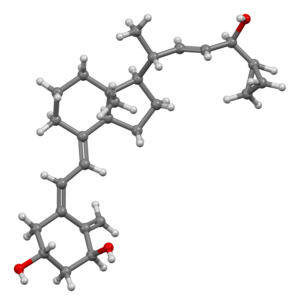カルシポトリオール
Calcipotriol/ja
カルシポトリオール(Calcipotriol)は、ビタミンDの一種であるカルシトリオールの合成誘導体である。 乾癬の治療に用いられる。乾癬性皮膚疾患への長期投与は安全である。
 | |
 | |
| Clinical data | |
|---|---|
| Trade names | Daivonex, Dovonex, Sorilux |
| Other names | calcipotriene (USAN US) |
| AHFS/Drugs.com | Monograph |
| MedlinePlus | a608018 |
| License data | |
| Pregnancy category |
|
| Routes of administration | Topical administration/ja |
| ATC code | |
| Legal status | |
| Legal status | |
| Pharmacokinetic data | |
| Bioavailability | 5 to 6% |
| Metabolism | Liver/ja |
| Excretion | 胆道 |
| Identifiers | |
| |
| CAS Number | |
| PubChem CID | |
| IUPHAR/BPS | |
| DrugBank | |
| ChemSpider | |
| UNII | |
| KEGG | |
| ChEBI | |
| ChEMBL | |
| Chemical and physical data | |
| Formula | C27H40O3 |
| Molar mass | 412.614 g·mol−1 |
| 3D model (JSmol) | |
| |
| |
| | |
1985年に特許を取得し、1991年に医療用として承認された。米国では「Dovonex」、北米以外では「Daivonex」、ドイツでは「Psorcutan」の商品名で販売されている。
世界保健機関の必須医薬品リストに掲載されている。
カルシポトリオールは、合成コルチコステロイドベタメタゾンジプロピオン酸エステルとの固定用量合剤カルシポトリオール/ベタメタゾンジプロピオン酸エステルとしても利用可能である。この合剤は、斑状乾癬の治療に使用される。
医薬用途
慢性尋常性乾癬はカルシポトリオールの主な医薬品用途である。また、円形脱毛症の治療にも使用され成功を収めている。
禁忌
過敏症、顔面への使用、高カルシウム血症、またはビタミンD毒性の証拠は、カルシポトリオール使用の唯一の禁忌である。
カルシポトリオールが光線過敏症を引き起こす可能性があるため、過度の自然光や人工光にさらされることに注意が必要である。
副作用
頻度別の副作用:
- 非常に多い(頻度10%以上):
- 熱感
- かゆみ
- 皮膚刺激
- 一般的である(1-10%の頻度):
- 一般的でない(頻度0.1-1%):
- 乾癬の増悪。
- まれである(頻度0.1%未満):
相互作用
薬物相互作用は知られていない。
薬理学
作用機序
乾癬の治療におけるカルシポトリオールの有効性は、骨粗鬆症の研究において、様々なビタミンDを投与された患者の観察から初めて注目された。 予期せぬことに、乾癬の患者も病変数が劇的に減少した。
寛解型乾癬におけるカルシポトリオールの正確な機序はよくわかっていない。 しかしながら、ビタミンD受容体(VDR)に対する親和性はカルシトリオールと同程度であり、カルシウム代謝を調節する活性はカルシトリオールの1%以下であることが示されている。 ビタミンD受容体はステロイド/甲状腺受容体スーパーファミリーに属し、甲状腺、骨、腎臓、免疫系のT細胞など、多くの異なる組織の細胞に存在する。T細胞は乾癬に関与していることが知られており、カルシポトリオールとVDRの結合がT細胞の分化・増殖関連遺伝子の転写を調節していると考えられている。
In mouse studies, topical calcipotriol administration to the ear and dorsal skin led to a dose-dependent increase in the production of the epithelial cell-derived cytokine TSLP by keratinocytes, and triggered atopic dermatitis at high concentrations. This upregulation of TSLP production due to calcipotriol application is thought to be mediated through the coactivation of vitamin D receptor/RXRα and vitamin D receptor/RXRβ heterodimers. As psoriasis is typically thought to be partially driven by Th1/Th17 inflammatory cytokines, calcipotriol treatment at appropriate concentrations may alleviate psoriasis symptoms by repressing Th1/Th17 inflammation through TSLP production, which is linked to a Th2 response. However, it is important to note that this has not yet been confirmed.
Pharmacokinetics
After application and systemic uptake, calcipotriol undergoes rapid hepatic metabolism. Calcipotriol is metabolized to MC1046 (the α,β−unsaturated ketone analog), which is subsequently metabolized to its primary metabolite, the saturated ketone analog MC1080. MC1080 is then slowly metabolized to calcitroic acid.
The metabolites of calcipotriol are less potent than the parent compound.
化学
カルシポトリオールは白色からほぼ白色の結晶性化合物である。
外部リンク
- "Calcipotriene". Drug Information Portal. U.S. National Library of Medicine.